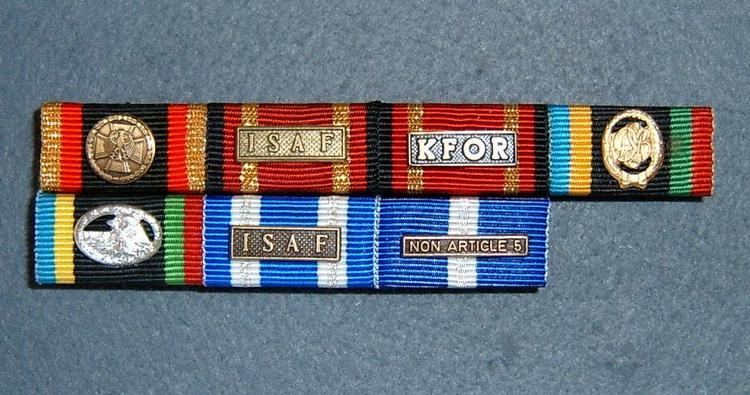 | ||
The Awards and decorations of the German Armed Forces are decorations awarded by the German Bundeswehr, the German government, and other organizations to the German military and allied forces. Modern era German military awards have been presented since the end of World War II and the establishment of the Federal Republic of Germany in 1949.
Contents
History
The history of German Armed Forces awards may be divided into three distinct eras, mainly Post-World War II decorations, Cold War era decorations, and modern day awards and medals.
Post World War II
At the end of the Second World War, Nazi Germany had amassed an extensive area of award and decorations both for military service, political service in the Nazi Party, and various other service medals and badges associated with the Nazi Germany expansion and activities.
Denazification edicts promptly declared the wear and display of former Nazi decorations as strictly prohibited. As Germany split apart into East and West Germany, each of these new countries issued directives concerning the status of former awards and decorations of Nazi Germany. Within East Germany, these awards were all but abolished with a new era of German Communist decorations created to take their place. However, in West Germany, by 1948 laws had been passed permitting the display of certain combat and military service medals from World War II, but also prohibiting continued display of Nazi political awards, awards directly associated with the SA or SS, as well as occupation service medals directly associated with the expansion of Nazi Germany in the 1930s.
Formal regulations issued in the mid-1950s had thereafter permitted the continued display of certain Wehrmacht decorations in ribbon form; the extensive use of neck orders and badges that had been prevalent under Nazi Germany was phased out in favor of the more common ribbon bar system used in western militaries.
Cold War Era
During the 1960s, West Germany became a key NATO member, serving as a major base for forward deployed United States and allied forces along the border with the Eastern Bloc. During this time period, the West German government began to slowly introduce new military awards and decorations, most of them for non-combat meritorious service.
Chief among these was the Order of Merit, considered the highest civilian decorations of Germany. Civil relief medals were also introduced into the German armed forces, beginning in 1962 with the first in series of Flood Relief Medals.
By the 1970s, German personnel were also eligible to receive foreign awards, most notable awards and decorations of the United States military. During the 1980s, the NATO Medal and United Nations Medal were also frequently awarded to German personnel.
Modern Day Awards
In the modern day German armed forces, several combat service medals exist due to German participation in overseas deployed missions in the War on Terror and other NATO-United Nations Peacekeeping ventures. German personnel are also eligible to receive and display civil service medals, sports and fitness awards, and certain marksmanship awards.
The reunification of Germany also saw new regulations concerning the status of East German awards introduced into the modern German military. These regulations typically stipulated that awards associated with the Communist regime were prohibited from display, but did recognize the status and continued wear of certain non-political service medals.
Federal Civil Decorations
Decorations of the Bundeswehr
Authorized Second World War Decorations
Flood Service Awards
Sports Decorations
Qualification insignia
Foreign awards
Frequent violations of wear
Some awards are awarded to German soldiers as a ribbon but are currently not permitted to be worn on uniforms of the German Armed Forces. Examples include:
